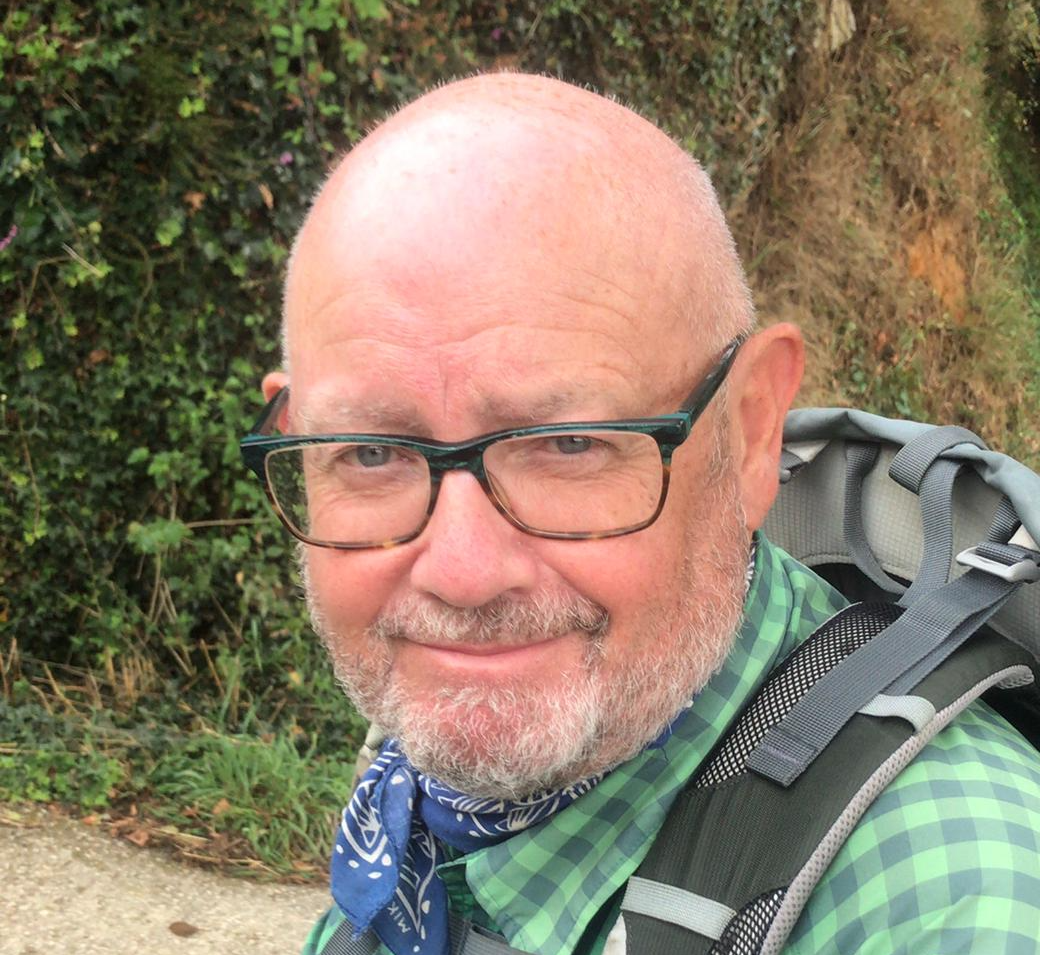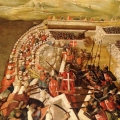When you arrive in Santiago, pilgrim, don’t miss the chance to stop by the welcome office and say hello to Johnnie Walker. Yes, he’s named after the famous whisky from his homeland. But he’s no ordinary volunteer—he’s a living institution on the Camino de Santiago after nearly 20 years of walking it without pause. So much so that he appears in the recent film The Way – My Way by Bill Bennett, playing himself.
John Rafferty, the real man behind Johnnie Walker, was once a successful executive in the United Kingdom. But his life took a radical turn after discovering the Camino de Santiago. In this candid conversation with Pilgrimaps, he shares how the pilgrimage transformed not only his life, but also the lives of thousands of English-speaking pilgrims whom he has accompanied, either personally or through his work, to the Tomb of the Apostle.
- Who was Johnnie Walker before discovering the Camino de Santiago?
I’m still the same person (laughing). My real name is John Rafferty. I was born in Glasgow, Scotland. At 24, I became director of a small NGO, which led to a career as chief executive of various organizations. I was married, I have two wonderful daughters, but my wife passed away some years ago.
Ver esta publicación en Instagram
For the last 15 years of my career, I helped organizations facing serious financial trouble. I was the guy who came in to lay people off, impose budgets and targets. I was tired of it all, even if I was successful. One highlight was being appointed the first director in Scotland to distribute National Lottery funding when it launched in 1993.
But I wanted a change by the time I turned 50. I dreamed of living in Spain. I’m a church organist—a passion since childhood. I began traveling to Seville, playing the organ in a church, dreaming of strolling down narrow streets and sipping manzanilla beneath an orange tree.
- How did the Camino first enter your life?
I was having dinner with the president of the organization I worked for. In his living room, he pointed to a map on the wall. It was the Camino Francés. I had never heard of it. “Do you know the Camino to Santiago?” he asked. “No.” “Santiago de Compostela?” “No.” “But you know Saint James the Apostle.” “Of course, I’m a church organist.”
His wife Jenny had walked the Camino in stages, and at dinner she lit up when she spoke about it. She talked about hostels, friendships, landscapes, food—people from everywhere, speaking different languages and understanding each other. That planted the seed.
As a young man, I hiked the Scottish hills, so I began to dream. Four years later, on January 2, 2007, I set off from Seville. I had just played the organ at the grand feast of Mary, Mother of God—an enormous event in Seville. They parade the Virgin out of the cathedral on live TV, and people bet on what she’ll be wearing. Very Andalusian.
After a few kilometers of walking, I looked back and thought: I’ll come back to Seville to spend the rest of my life.
- What happened when you arrived in Santiago?
Thirty-six days later, I reached the Cathedral of Santiago and everything had changed for me. I had fallen completely in love with the idea of pilgrimage. I’d had many kilometers to reflect—to think, cry, laugh. I hadn’t spoken English for three weeks. And when I arrived, I thought: Maybe Santiago is the place for me.
- Why did you choose to start from Seville specifically?
Because of my love for Seville. I still have friends there who think I’m crazy. “Why do you live in rainy Galicia?” But it’s wonderful here.
- When did you realize your experience on the Camino could become a calling?
If you give me a problem, I try to find a solution—that’s how my mind works. When I arrived, the cathedral was full of pilgrims. Pilgrims were sitting on the steps of the altar, backpacks everywhere. I remember seeing the priest’s boots under his vestments – it was very moving. But no one spoke a word of English.
So I knocked on the door of the Pilgrim Office and said, “My name is John. I’ve come to volunteer.” Volunteering isn’t very common in Spain. They were confused: “What is this?” I said I’d welcome English-speaking pilgrims, write their Compostelas, pay my own expenses. I became their first volunteer.

- And that’s when the English-language Mass began?
Yes! The Germans had their Mass in German. I went to the Dean and said, “Can I start organizing an English-language Mass?” He asked, “How much will it cost?” I said, “Nothing.” “And where will you get priests?” “I’ll find them.” I asked English-speaking Camino associations for help. The Irish were the first to say yes—they’ve always been great. We raised funds, rented apartments for volunteers, who stayed for 15 days. It was a pilot project for three years, and it worked.
Then I asked my former parish in London to send priests to Santiago on vacation in exchange for saying daily Mass. They sent two. The pilgrims loved it. At the beginning of Mass, we’d ask them to introduce themselves: “My name is so-and-so, I came from Seville, I walked from Sarria…” The pilgrims loved sharing. We also collected donations, and it became a sustainable ministry.
I even posted an ad: “Wanted: Catholic priests who have walked the Camino and are willing to volunteer.” We received 27 applications. Twenty-four were accepted. Daily English Mass for six months. It was wonderful.
- You also helped revive the Camino Inglés, didn’t you?
In 2007, I wanted to keep walking and read about the Camino Inglés. I contacted the Confraternity of Saint James in London—but they only had outdated notes. “If you write a guide, we’ll publish it,” they said. So I wrote my first guide in 2008.
That year, 1,200 pilgrims walked the route. Last year, 28,000. There were no other guides at the time. Since then, I’ve written 19 more. I opened up little-known routes—Portuguese, coastal, along the sea. It became almost an obsession.
- What did you do during the COVID lockdowns?
During the pandemic, we were locked down. But eventually walking between regions was allowed. I posted on Facebook: “If you want me to pray for you, send me an email.” I opened a Gmail account—wewalkforyou—and received nearly 400 messages. People asked for prayers for marriages, children, illnesses.
I carried the intentions on a USB stick. In chapels, we placed it on the altar and prayed. We also launched a poster campaign: “Dear Camino, we will return.” Local newspapers printed hundreds of pilgrim letters. It was deeply moving.
- What makes the Camino different from any other long-distance trail?
It’s a sacred path. Pilgrimage means stepping out of your usual life to go to a sacred place. The farther you walk, the deeper the experience. There’s the warmth of the locals—I remember elderly women in the countryside shouting “¡Buen Camino!” And you live simply, with a backpack.
One day I realized: if everything collapsed—if those who love me stopped loving me, if I lost my pension, if my house burned down—I could grab two pairs of socks, two shirts, two pairs of underwear, and walk the Camino. And I’d be happy. That’s liberation.
- What have you learned from watching other pilgrims arrive in Santiago?
I’ve never seen a pilgrim arrive in the Plaza del Obradoiro without crying. Those tears are for the achievement, the gratitude, and the sadness that this incredible experience is ending. My theory is that every pilgrim wants to change in some way – to be a better person. And upon arrival, they ask themselves: “Will I have the courage to make that change?”
- What still surprises you when walking the Camino?
I still get nervous. My feet still hurt. I still ask myself, “John, why are you doing this?” But I love it. I’ve started handing my walking stick to elderly men sitting outside bars and saying, “Come with me to Santiago!” They laugh and say, “I can’t, my hip’s bad.” It’s a wonderful way to break the ice. Spaniards love to talk if you give them a chance.
- What message would you leave for future pilgrims?
In Bill Bennett’s film, someone says: “You must walk with your heart in your hand.” That’s it. What matters isn’t your backpack or your route. It’s your openness. Be open to what the Camino offers you. If someone reaches out – take their hand. If someone shares – share in return. Be honest. Be receptive. And the magic will happen.





